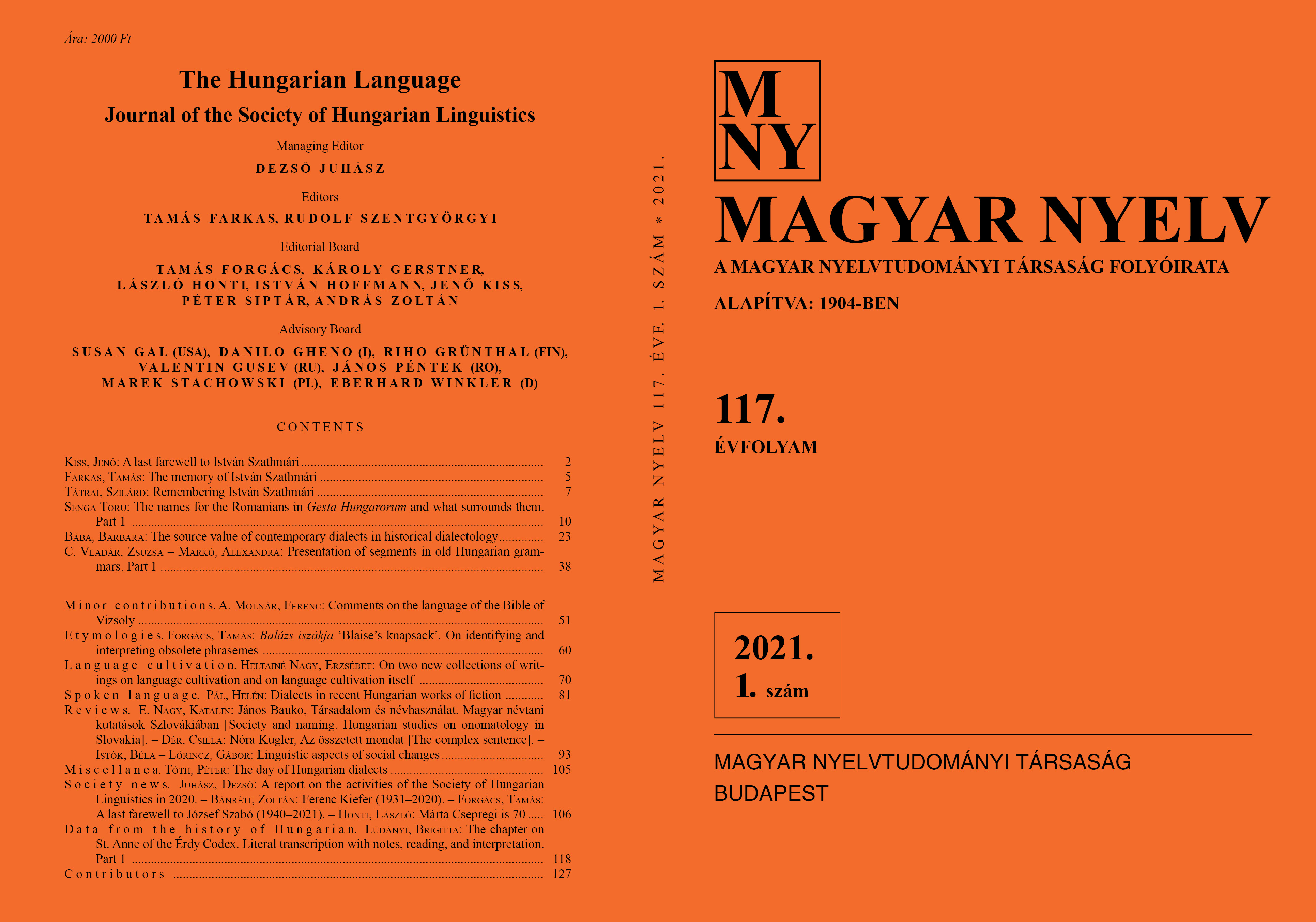The names for the Romanians in Gesta Hungarorum and what surrounds them
Part 1
DOI:
https://doi.org/10.18349/MagyarNyelv.2021.1.10Keywords:
Gesta Hungarorum, Romanians, ethnonyms, xenonyms, vlach, oláh, olaszAbstract
The three names for Vlachs (plur. Blachii, Blasii, Blaci) used by Anonymus (the anonymous notary of King Béla III), by removing the Latin endings, are actually the ethnonyms Blach (not Blachi), Blas (not Blasi) and Blac. None of them is a Hungarian language form (>oláh), and none of them can be directly related to the Slavic form, vlach (plur. vlasi > olasz). The author of the Gesta Hungarorum, who acted in official affairs not only when he was a notary but also in later times, could use his information in writing his chronicle. Anonymus refers to the lord of Transylvania, Gelou, as the prince of the Vlachs (dux Blacorum), which is in harmony with the fact that the form Blaci was used to denote the Vlachs of southern Transylvania in the charters of King Andrew II. Considering that the Latin literacy of Hungary was influenced by the papal chancellery, it is not surprising that the phrase Bulgarii et Blachii was modelled on the terms used in the papal chancellery, especially in the letters of Pope Innocent III, in which Bulgarians and Vlachs appear together (Bulgaria et Blachia, Bulgarorum et Blachorum, etc.). Anonymus borrowed the phrase Cumanorum et Bulgarorum atque Blacorum from a circular letter of the Latin emperor Henry of Flanders, which was also sent to the court of King Andrew II in 1213. The name Blas, which corresponds to the name used in French writings on the Fourth Crusade to denote Balkan Vlachs, was used for the Transylvanian Vlachs by Anonymus, who was in contact with the Walloon and French-speaking settlers in Hungary. The chronicler probably drew the three names in question from the sources of the first two decades of the 13th century.
Downloads
Published
Issue
Section
License
Copyright (c) 2024 Toru Senga

This work is licensed under a Creative Commons Attribution-NonCommercial-NoDerivatives 4.0 International License.
Magyar Nyelv is a Diamond Open Access periodical. Documents can be freely downloaded and duplicated in an electronic format, and can be used unchanged and with due reference to the original source. Such use must not serve commercial purposes. In the case of any form of dissemination and use, Hungarian Copyright Act LXXVI/1999 and related laws are to be observed. The electronic version of the journal is subject to the regulations of CC BY-NC-ND (Creative Commons – Attribution-NonCommercial-NoDerivatives).
The journal permits its authors, at no cost and without any temporal limitation, to make pre-print copies of their manuscripts publicly available via email or in their own homepage or that of their institution, or in either closed or free-for-all repositories of their institutions/universities, or other non-profit websites, in the form accepted by the journal editor for publication and even containing amendments on the basis of reviewers’ comments. When the authors publicize their papers in this manner, they have to warn their readers that the manuscript at hand is not the final published version of the work. Once the paper has been published in a printed or online form, the authors are allowed (and advised) to use that (post-print) version for the above purposes. In that case, they have to indicate the exact location and other data of the journal publication. The authors retain the copyright of their papers; however, in the case of an occasional secondary publication, the bibliographical data of the first publication have to be included.



